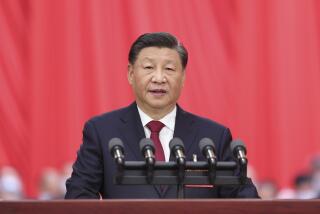A Miracle With New Correctives
- Share via
Three summers ago, Asia was starting to feel the economic heat from the collapse of Thailand’s national currency and the trouble threatened to spread to the West. Today, one Asian economy after another appears to be revived, and America continues its amazing economic run as if nothing had happened. But it was Asia’s biggest postwar fright, and two noted economists believe the world has learned enduring lessons from the trauma.
The first is Laura D’Andrea Tyson, the former chair of President Clinton’s Council of Economic Advisors. Even a few months ago, I and a fair number of other observers continued to worry that the region could be heading for a second bruising. However, Tyson has a persuasively different view. During an interview in her dean’s office at UC Berkeley’s Haas School of Business, she saw mainly sunshine: “The bad news, it is true,” she says, “is that we were not able to predict the Asian crisis. And the fact that we weren’t should give us a considerable amount of humility in saying that we think there won’t be another one. But we have managed as a system to contain the effects. So the good news is that even when a crisis is severe, it can be relatively contained.”
Tyson proposes that our lightning-fast global financial system can be understood as a paradox. She scarcely denies its frightening capabilities--that economic disturbances move from one country to another with a velocity that is breathtaking, and that the amounts of capital moved are unprecedented. Even so, she says, the system is beginning to look like one that learns to solve self-created crises almost as quickly as it generates them. It may trigger serious problems overnight but then recover with computer-age alacrity. The very information technology that permits rapid withdrawal of money from an economy also allows large amounts of capital to be instantly re-injected. Says Tyson: “There was the ability to put together in a pragmatic way--a little of this and a little of that--which worked as a policy approach. A lot of money was mobilized to keep these systems from sinking further.”
The second major expert with a positive perspective on the Asian crisis is economist William Overholt at Nomura International Ltd. The Hong Kong-based Overholt, one of the region’s most respected analysts, believes that the crisis has persuaded many, if not all, Asian nations, of what is in effect a truism: Reforms are happening because reforms previously instituted--from banking transparency to leaner bureaucracies--are working. “The Asian miracle is back--to stay,” he says. “The miracle growth rates have returned.”
Nomura has issued its summer report on the comeback. Slow-but-steady China, with a growth rate this year of about 8%, has been laying off something like 10 million state workers a year to squeeze the flab out of its public sector. Resurgent South Korea, with an ever higher growth rate, has been cleaning up its banks and transforming the nature of its economy from bureaucratic to entrepreneurial. An alert Singapore is making structural changes in its economy and moving to a more open immigration policy designed to lure the best foreign talent available. Malaysia, which shrugged off gloom-and-doom predictions from the West when it violated economic canons by experimenting with capital controls, has taken on the giant task of repairing its banking system. Export-happy Taiwan, with 8% growth rates, has been cutting back on debt and tightening up its economy in long-held anticipation of entry into the World Trade Organization. Even the yo-yo economy in Hong Kong posted double-digit growth earlier this year.
Granted, some Asian economies have not done their reform homework. “Thailand and the Philippines are still limping,” admits Overholt, “and Indonesia is a total mess.” This is not immaterial: Indonesia is the most populous country in Southeast Asia and the fourth most populous in the world. These three Southeast Asian economies together are suffocating under mountains of debt: If they falter further, what effect will they have on the regional neighborhood? Even now, the currencies of otherwise recovering Seoul and Singapore are struggling; ominously, so is the Thai baht, down by a third again.
Let’s remember that the lesson of 1997 was that today’s Asia is, for better and for worse, an increasingly integrated economic neighborhood: Half of its trade takes place within the region. Its recent climb out of the tank was due more to increased trade within the region than outside of it. In 1997, when currency infections began to drag down the Thai economy, a lot of people said, who cares? But as Thailand went, so went the neighborhood. New troubles there, from whatever source, could have that effect again. Overholt suggests this probably won’t happen; Tyson says if it does, the collective corrective response will be as rapid as the crisis. Let’s hope that the Overholt truism prevails in Asia so that Tyson’s paradox won’t ever have to be tested.
More to Read
Inside the business of entertainment
The Wide Shot brings you news, analysis and insights on everything from streaming wars to production — and what it all means for the future.
You may occasionally receive promotional content from the Los Angeles Times.










